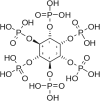Phytase in non-ruminant animal nutrition: a critical review on phytase activities in the gastrointestinal tract and influencing factors
- PMID: 25382707
- PMCID: PMC4368368
- DOI: 10.1002/jsfa.6998
Phytase in non-ruminant animal nutrition: a critical review on phytase activities in the gastrointestinal tract and influencing factors
Abstract
This review focuses on phytase functionality in the digestive tract of farmed non-ruminant animals and the factors influencing in vivo phytase enzyme activity. In pigs, feed phytase is mainly active in the stomach and upper part of the small intestine, and added phytase activity is not recovered in the ileum. In poultry, feed phytase activities are mainly found in the upper part of the digestive tract, including the crop, proventriculus and gizzard. For fish with a stomach, phytase activities are mainly in the stomach. Many factors can influence the efficiency of feed phytase in the gastrointestinal tract, and they can be divided into three main groups: (i) phytase related; (ii) dietary related and (iii) animal related. Phytase-related factors include type of phytase (e.g. 3- or 6-phytase; bacterial or fungal phytase origin), the pH optimum and the resistance of phytase to endogenous protease. Dietary-related factors are mainly associated with dietary phytate content, feed ingredient composition and feed processing, and total P, Ca and Na content. Animal-related factors include species, gender and age of animals. To eliminate the antinutritional effects of phytate (IP6), it needs to be hydrolyzed as quickly as possible by phytase in the upper part of the digestive tract. A phytase that works over a wide range of pH values and is active in the stomach and upper intestine (along with several other characteristics and in addition to being refractory to endogenous enzymes) would be ideal.
Keywords: digestive tract; fish; phytase activity; pigs; poultry.
© 2014 The Authors. Journal of the Science of Food and Agriculture published by John Wiley & Sons Ltd on behalf of Society of Chemical Industry.
Figures







References
-
- Lei XG, Weaver JD, Mullaney E, Ullah AH, Azain MJ. Phytase, a new life for an 'old' enzyme. Annu Rev Anim Biosci. 2013;1:283–309. - PubMed
-
- Adeola O, Cowieson AJ. Board-invited review: opportunities and challenges in using exogenous enzymes to improve nonruminant animal production. J Anim Sci. 2011;89:3189–3218. - PubMed
-
- AOAC. Official Methods of Analysis of AOAC International. 17th edn. Arlington, VA: Association of Official Analytical Chemists; 2000. Method 2000.12: Phytase activity in feed: colorimetric enzymatic method.
-
- Selle PH, Ravindran V. Review: Microbial phytase in poultry nutrition. Anim Feed Sci Technol. 2007;135:1–41.
-
- Woyengo TA, Nyachoti CM. Review: Supplementation of phytase and carbohydrases to diets for poultry. Can J Anim Sci. 2011;91:177–192.
Publication types
MeSH terms
Substances
LinkOut - more resources
Full Text Sources
Other Literature Sources
Medical

